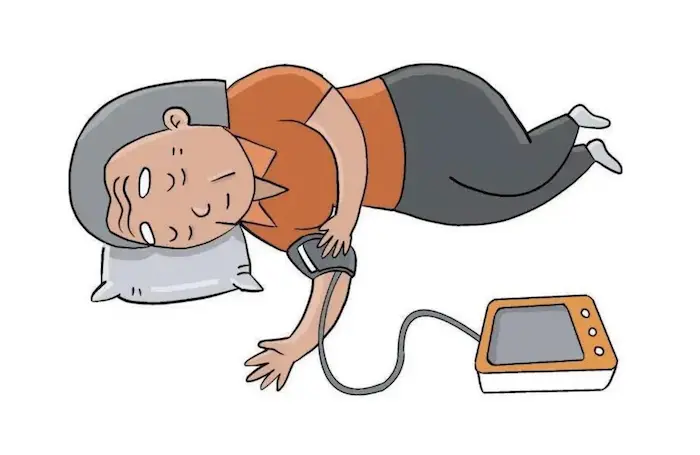Orthostatic hypotension (OH) is a form of low blood pressure. It occurs when a person stands up from a sitting or lying position. The sudden drop in blood pressure can cause dizziness, lightheadedness, or even fainting. The condition is typically diagnosed when systolic blood pressure falls by at least 20 mm Hg or diastolic pressure falls by 10 mm Hg within three minutes of standing.
Mechanism Behind Orthostatic Hypotension
Normally, when a person stands up, gravity causes blood to pool in the lower body. To compensate, the body constricts blood vessels and increases heart rate. This helps maintain blood pressure and ensure blood flow to the brain. In people with OH, this response is impaired.
What Worsens Orthostatic Hypotension?
Dehydration
Dehydration reduces the total blood volume. This makes it harder for the body to maintain blood pressure upon standing.
Lack of fluids is a major contributor to worsening symptoms.
Prolonged Bed Rest or Inactivity
Long periods of bed rest or inactivity weaken the cardiovascular reflexes. Muscle pump activity also decreases, leading to more pooling of blood in the lower extremities. This makes standing more difficult and worsens OH symptoms.
Alcohol Consumption
Alcohol is a vasodilator. It causes blood vessels to widen, which lowers blood pressure. In people with OH, alcohol can greatly intensify symptoms and increase the risk of fainting.
Heat Exposure
Exposure to heat, such as from hot weather, saunas, or hot baths, dilates blood vessels and promotes sweating. This further reduces blood volume and increases the risk of hypotensive episodes.
Large Meals
After eating, blood flows to the digestive system. In people with OH, this shift in blood distribution can worsen symptoms, especially after high-carbohydrate meals.
Certain Medications
Many medications can worsen OH. These include:
- Diuretics (increase urination and reduce blood volume)
- Alpha-blockers (cause vasodilation)
- Beta-blockers (slow the heart rate)
- Tricyclic antidepressants
- Levodopa used for Parkinson’s disease
Combining these drugs can significantly impair the body’s ability to regulate blood pressure.
Neurological Disorders
Conditions such as Parkinson’s disease, multiple system atrophy, and diabetic neuropathy can damage the autonomic nervous system. This disrupts blood pressure regulation, making OH worse.
Heart Conditions
Diseases like heart failure or arrhythmias reduce the heart’s ability to pump blood effectively. This impairs the response to standing and contributes to worsening orthostatic hypotension.
Age
Aging leads to a less responsive cardiovascular system. The baroreceptor reflex weakens, and the heart takes longer to adjust to posture changes. This makes elderly people more vulnerable to OH and its triggers.
Symptoms That May Indicate Worsening
Dizziness and Lightheadedness
These symptoms often appear when standing up and may become more frequent or intense as OH worsens.
Blurry Vision or Tunnel Vision
These visual disturbances are a result of reduced blood flow to the brain.
Fatigue
Chronic fatigue can occur due to ongoing issues with blood circulation and oxygen delivery to tissues.
Fainting
Fainting episodes indicate a severe drop in cerebral perfusion and suggest that OH is poorly controlled.
Diagnosis and Monitoring
Blood Pressure Monitoring
Measuring blood pressure lying down and then standing is a standard method. Repeating this over time can help track progression.
Heart Rate and ECG
Monitoring heart rate changes and performing electrocardiograms (ECG) can help identify underlying heart issues.
Tilt Table Testing
This test evaluates the cardiovascular response to changes in posture. It can help diagnose the severity and cause of OH.
How to Prevent Orthostatic Hypotension From Worsening
Hydration and Salt Intake
Drinking adequate fluids increases blood volume. In some cases, increasing salt intake helps retain fluids and supports blood pressure regulation.
Compression Garments
Compression stockings or abdominal binders prevent blood pooling in the lower body and support venous return to the heart.
Slow Position Changes
Getting up slowly from lying or sitting positions gives the body time to adjust blood pressure and reduces dizziness.
Elevating the Head of the Bed
Sleeping with the head of the bed slightly elevated can reduce nocturnal urine production and minimize morning hypotension.
Regular Physical Activity
Exercise strengthens the heart and improves vascular tone. Activities like walking and light resistance training are recommended.
Medications
Some drugs help raise blood pressure, such as:
- Fludrocortisone – increases blood volume
- Midodrine – constricts blood vessels
- Droxidopa – increases norepinephrine levels
These medications must be used under medical supervision to avoid complications.
When to See a Doctor
Persistent Symptoms
If symptoms occur daily or interfere with normal activities, medical evaluation is essential.
History of Falls
Frequent falls due to OH increase the risk of injury. Medical intervention can help prevent future episodes.
Medication Adjustment
If symptoms began after starting a new medication, speak to your doctor about alternatives or dosage changes.
Conclusion
Orthostatic hypotension can worsen due to several factors including dehydration, medications, neurological diseases, and aging. It is crucial to recognize the warning signs early and adopt measures to manage the condition. By addressing these triggers and working closely with a healthcare provider, most individuals can minimize symptoms and improve their quality of life.
Related topics:


